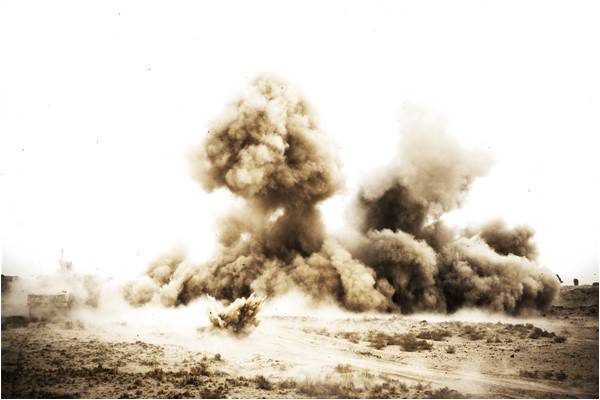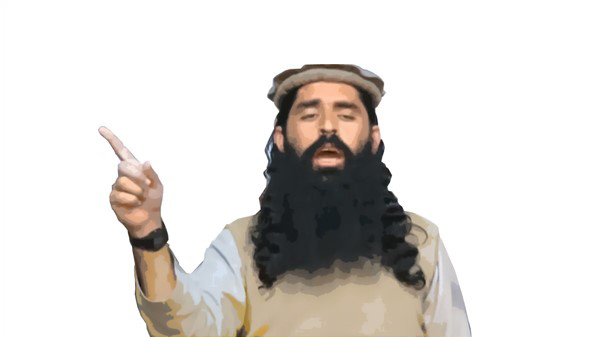
A US drone strike in the Nangarhar province of Afghanistan killed the mastermind of the ruthless 2014 massacre at the Army Public School in Peshawar, Pakistani military and US officials revealed on July 13.
The death of Khalifa Omar Mansoor, a leading commander of the Pakistani Taliban (or TTP), may come as an irreparable loss to the already weakened TTP led by Mullah Fazlullah, experts say.
Amongst his Taliban fellows, the long-haired militant with a flowing chest-length beard is known as Umar Naray, or Umar the Slim. Once a leader of TTP’s Geedar (Jackal) group operating in Peshawar, Darra Adam Khel and the surrounding towns, he became increasingly important to Mullah Fazlullah as other top commanders began to leave him in the last few years.
A volleyball enthusiast and a father of three, he had been hiding across the border in Afghanistan. Locals say he used to cross over to the tribal areas occasionally.
The Geedar Group of the Taliban was formed by Tariq Afridi Geedar, a close associate of the dead TTP ex-emir Hakimullah Mehsud. Following his killing in early 2013, Muhammad Arif Kaka was handed over the affairs of the group. There is no information on what happened to Kaka and under what circumstances Umar Mansoor took over from him.
He first made headlines when he claimed responsibility for the attack on the Army Public School in Peshawar in the December 2014. Reuters called him Pakistan’s most hated man. Umar Mansoor is believed to be behind all key Taliban attacks in Pakistan in the last year. In January this year, he claimed the attack on the Bacha Khan University in Charsadda, and threatened to carry out more such attacks.
The commander of NATO’s Resolute Support Mission called army chief Gen Raheel Sharif to tell him about the development, according to a tweet by army spokesman Lt Gen Asim Bajwa. “Comd RSM called COAS, confirmed death of terrorist Umar Narai alias Khalifa Umar, also alias Khalid Khurasani through drone strike in Afghanistan,” he said.
Taliban’s response to the announcement did not address the militant commander’s death. A one-page handbill they shared with reporters alleged the military spokesman didn’t know Khalifa Omar Mansoor and Khalid Khurasani were two different people. The pamphlet had pictures of Khalifa Omar Mansoor and Omar Khalid Khurasani. The latter is the head of Jamaatul Ahrar, a splinter group of TTP. They did not confirm or deny whether the former had died. The caption to his photograph used the word “shaheed”, or martyr, which was removed in a corrected version released subsequently.
On July 16, Afghan President Ashraf Ghani telephoned Prime Minister Nawaz Sharif and told him Khalifa Omar Mansoor and four other Taliban commanders had been killed. “Ghani informed the PM that the mastermind of APS’ massacre Omar Khurasani along with his four accomplices was killed few days back in coalition forces strike,” says a statement issued by the Prime Minister’s House. It calls the man “Omar Khurasani”.
A number of sources and reporters in the tribal areas I spoke to could not confirm the killing of Khalifa Omar Mansoor. “The militants release an audio or video message by their leader if he is alive but being reported dead,” one reporter told me. “Their silence means he has been eliminated.”
If Khalifa Omar Mansoor is indeed dead, Fazlullah has lost one of his most important commanders whose influence had spread from the Peshawar valley and the tribal areas to the southern port city of Karachi, and the Nangarhar, Kunar and Nuristan provinces of Afghanistan.

Since he became the head of TTP in 2013, Fazlullah has not been able to keep the outfit intact. In May 2014, Khan Said Sajna – a key commander and leader of militants with a Mehsud tribal background –parted ways with the TTP. Two months later, a number of high profile commanders including Omar Khalid Khurasani, then head of the TTP in Mohmand agency, and Ihsanullah Ihsan, former central spokesman of the outfit, left him and formed Jamaatul Ahrar. In October 2014, five top Taliban leaders –including Hafiz Saeed Khan, the TTP leader in Orakzai and Kurram agencies – swore allegiance to Abu Bakr Al-Baghdadi’s Islamic State (IS).
After Sajna left him, Fazlullah had been relying on the Hakimullah Mehsud faction of Taliban in South Waziristan. Most of the key commanders of the group are relatives of the dead Taliban leader Hakimullah Mehsud. In June, seven members of the faction surrendered to Pakistani security forces in Kurram Agency. Hakimullah Mehsud’s brother Ejaz Mehsud and Uncle Khair Muhammad were amongst them.
Rasool Dawar, a Peshawar-based journalist who closely watches Taliban affairs, said Khalifa Omar Mansoor was an ideologue and a strategic planner, who trained suicide attackers. He was among the most dreaded commanders of Pakistani Taliban. “Unlike other TTP commanders, he did not hesitate to claim responsibility for attacking schools, colleges and other public places.”
He had contacted several reporters on the phone and on Facebook after the 2014 APS massacre, and proudly claimed credit.
“We will continue to attack schools, colleges, and universities across Pakistan as they are the foundations that produce apostates. We will target and demolish these foundations,” he had said in a statement following the Bacha Khan University raid in January, in which 20 people were killed and more than two dozen were injured.
He had organized his group in Karachi recently, veteran journalist Zia ur Rehman told me, and ran an extortion campaign targeting Pashtun traders belonging to the Afridi clan.
“The Karachi operation had weakened the outfit,” he said. “His death, if confirmed, is a great blow to the TTP set-up.”
The death of Khalifa Omar Mansoor, a leading commander of the Pakistani Taliban (or TTP), may come as an irreparable loss to the already weakened TTP led by Mullah Fazlullah, experts say.
Amongst his Taliban fellows, the long-haired militant with a flowing chest-length beard is known as Umar Naray, or Umar the Slim. Once a leader of TTP’s Geedar (Jackal) group operating in Peshawar, Darra Adam Khel and the surrounding towns, he became increasingly important to Mullah Fazlullah as other top commanders began to leave him in the last few years.
A volleyball enthusiast and a father of three, he had been hiding across the border in Afghanistan. Locals say he used to cross over to the tribal areas occasionally.
"We will continue to attack schools," he had said. "They produce apostates"
The Geedar Group of the Taliban was formed by Tariq Afridi Geedar, a close associate of the dead TTP ex-emir Hakimullah Mehsud. Following his killing in early 2013, Muhammad Arif Kaka was handed over the affairs of the group. There is no information on what happened to Kaka and under what circumstances Umar Mansoor took over from him.
He first made headlines when he claimed responsibility for the attack on the Army Public School in Peshawar in the December 2014. Reuters called him Pakistan’s most hated man. Umar Mansoor is believed to be behind all key Taliban attacks in Pakistan in the last year. In January this year, he claimed the attack on the Bacha Khan University in Charsadda, and threatened to carry out more such attacks.
The commander of NATO’s Resolute Support Mission called army chief Gen Raheel Sharif to tell him about the development, according to a tweet by army spokesman Lt Gen Asim Bajwa. “Comd RSM called COAS, confirmed death of terrorist Umar Narai alias Khalifa Umar, also alias Khalid Khurasani through drone strike in Afghanistan,” he said.
Taliban’s response to the announcement did not address the militant commander’s death. A one-page handbill they shared with reporters alleged the military spokesman didn’t know Khalifa Omar Mansoor and Khalid Khurasani were two different people. The pamphlet had pictures of Khalifa Omar Mansoor and Omar Khalid Khurasani. The latter is the head of Jamaatul Ahrar, a splinter group of TTP. They did not confirm or deny whether the former had died. The caption to his photograph used the word “shaheed”, or martyr, which was removed in a corrected version released subsequently.
He was an ideologue and a strategic planner, and trained suicide attackers
On July 16, Afghan President Ashraf Ghani telephoned Prime Minister Nawaz Sharif and told him Khalifa Omar Mansoor and four other Taliban commanders had been killed. “Ghani informed the PM that the mastermind of APS’ massacre Omar Khurasani along with his four accomplices was killed few days back in coalition forces strike,” says a statement issued by the Prime Minister’s House. It calls the man “Omar Khurasani”.
A number of sources and reporters in the tribal areas I spoke to could not confirm the killing of Khalifa Omar Mansoor. “The militants release an audio or video message by their leader if he is alive but being reported dead,” one reporter told me. “Their silence means he has been eliminated.”
If Khalifa Omar Mansoor is indeed dead, Fazlullah has lost one of his most important commanders whose influence had spread from the Peshawar valley and the tribal areas to the southern port city of Karachi, and the Nangarhar, Kunar and Nuristan provinces of Afghanistan.

Since he became the head of TTP in 2013, Fazlullah has not been able to keep the outfit intact. In May 2014, Khan Said Sajna – a key commander and leader of militants with a Mehsud tribal background –parted ways with the TTP. Two months later, a number of high profile commanders including Omar Khalid Khurasani, then head of the TTP in Mohmand agency, and Ihsanullah Ihsan, former central spokesman of the outfit, left him and formed Jamaatul Ahrar. In October 2014, five top Taliban leaders –including Hafiz Saeed Khan, the TTP leader in Orakzai and Kurram agencies – swore allegiance to Abu Bakr Al-Baghdadi’s Islamic State (IS).
After Sajna left him, Fazlullah had been relying on the Hakimullah Mehsud faction of Taliban in South Waziristan. Most of the key commanders of the group are relatives of the dead Taliban leader Hakimullah Mehsud. In June, seven members of the faction surrendered to Pakistani security forces in Kurram Agency. Hakimullah Mehsud’s brother Ejaz Mehsud and Uncle Khair Muhammad were amongst them.
Rasool Dawar, a Peshawar-based journalist who closely watches Taliban affairs, said Khalifa Omar Mansoor was an ideologue and a strategic planner, who trained suicide attackers. He was among the most dreaded commanders of Pakistani Taliban. “Unlike other TTP commanders, he did not hesitate to claim responsibility for attacking schools, colleges and other public places.”
He had contacted several reporters on the phone and on Facebook after the 2014 APS massacre, and proudly claimed credit.
“We will continue to attack schools, colleges, and universities across Pakistan as they are the foundations that produce apostates. We will target and demolish these foundations,” he had said in a statement following the Bacha Khan University raid in January, in which 20 people were killed and more than two dozen were injured.
He had organized his group in Karachi recently, veteran journalist Zia ur Rehman told me, and ran an extortion campaign targeting Pashtun traders belonging to the Afridi clan.
“The Karachi operation had weakened the outfit,” he said. “His death, if confirmed, is a great blow to the TTP set-up.”

